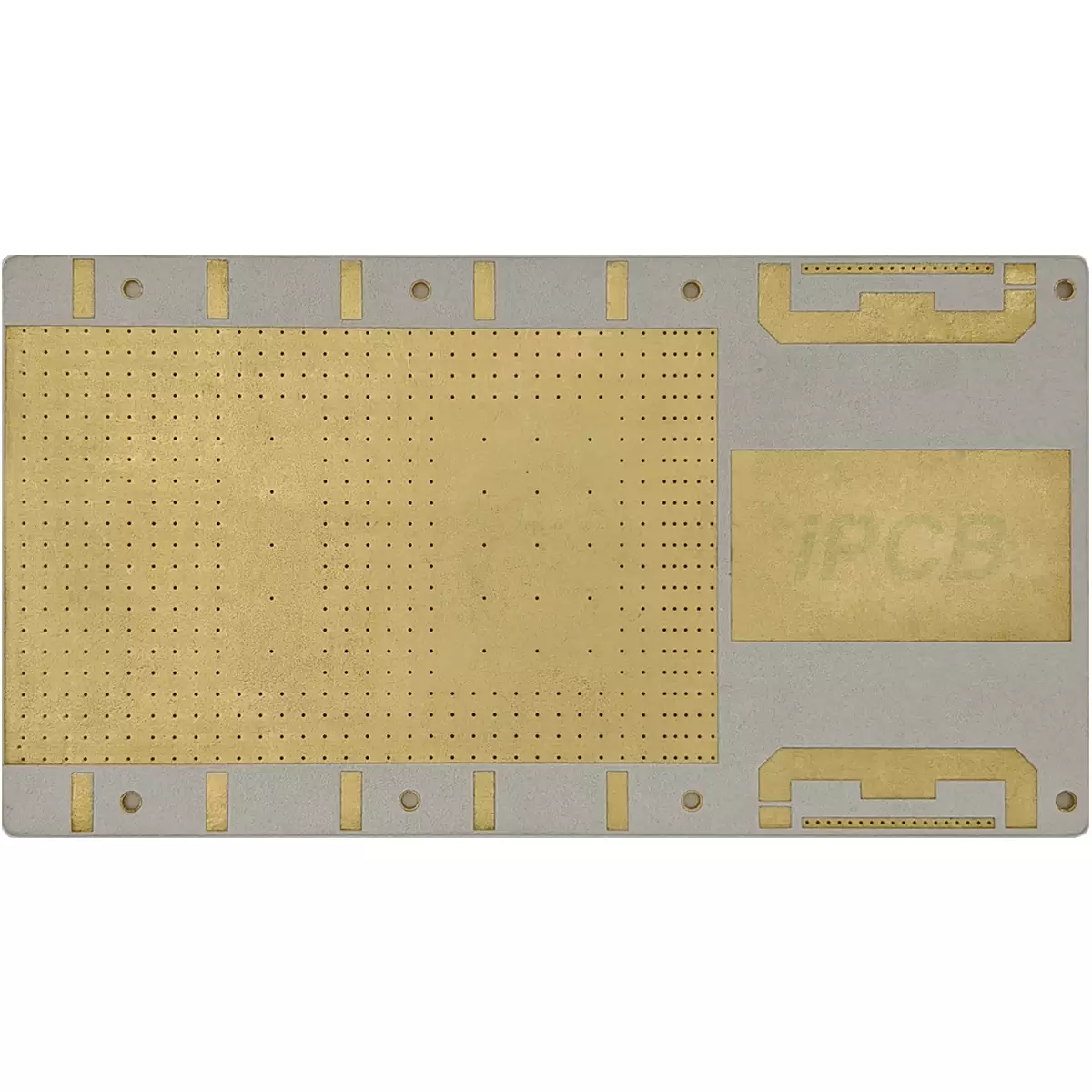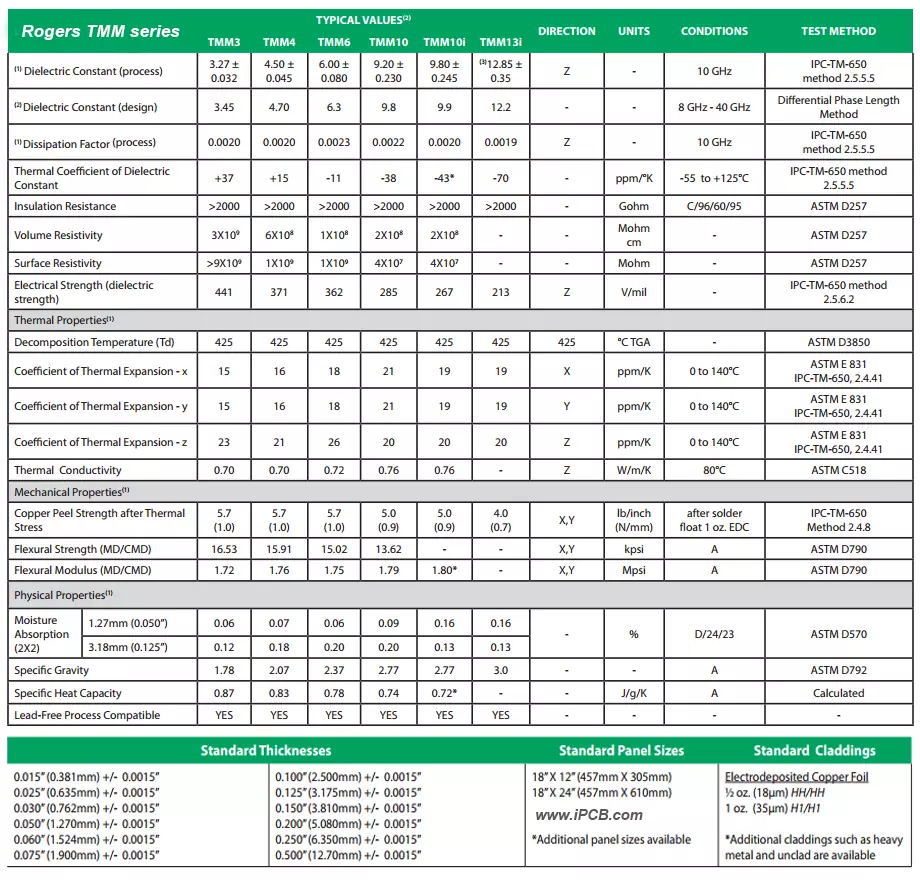
Product: Rogers TMM Circuit Board
Material: TMM series
Layer: 2l
TMM Dk: 3.45-12.2
TMM thickness: 15mil-500mil
TMM copper thickness: 0.5oz
Outer copper thickness: 1oz
Solder mask colors: green, red, blue
Surface treatment: Gold
Application: microwave circuit
Rogers TMM series high-frequency materials have excellent electrical properties and mechanical stability, making them highly suitable for high reliability applications in strip and microstrip lines. All media materials can be provided in 3D form through compression molding. The formed TMM components provide new innovative design solutions for high-frequency or low-frequency applications that require stable dielectric constant and low loss factor.
TMM thermosetting microwave material is a ceramic, hydrocarbon, and thermosetting polymer TMM RF material designed for high reliability electroplated through-hole applications such as strip lines and microstrip lines. It can provide a variety of different dielectric constants and copper types.
The electrical and mechanical properties of TMM high-frequency materials combine various advantages of ceramics and traditional PTFE microwave high-frequency materials, so there is no need to use special production processes in manufacturing. Similarly, TMM high-frequency materials do not require sodium treatment before chemical copper plating.
TMM high-frequency materials have extremely low dielectric constant thermal temperature coefficient, typically below 50ppm/oc, and also exhibit isotropic thermal expansion system, which is very close to the thermal expansion coefficient of copper. This makes TMM high-frequency materials highly reliable for electroplating through holes and have extremely low etching shrinkage values. In addition, the thermal conductivity of TMM high-frequency materials is twice that of traditional PTFE/ceramic high-frequency materials, making them easy to dissipate heat,
TMM high-frequency materials are based on thermosetting resin materials, which do not soften during heating. Therefore, the circuit connections between components and circuits can be very intact without worrying about solder pad detachment or material deformation.
TMM high-frequency materials combine many characteristics of ceramic materials while reducing the need for special processing techniques for soft materials during processing. TMM high-frequency materials can provide electrolytic feeding from 1/2 oz/ft2 to 2 oz/ft2, and can also directly bond brass or aluminum substrate materials with a thickness range from 0.015 "to 0.500". Can resist the influence of etchants and solvents during the production process of printed circuits, Therefore, all commonly used PWB processes can be used to process TMM thermosetting microwave materials.
TMM thermosetting microwave high-frequency materials and 3D molded dielectric materials have a low dielectric constant (Dk) thermal coefficient, as well as a thermal expansion coefficient that matches copper and a very uniform dielectric constant characteristic.
Advantages of Rogers TMM series high-frequency materials
1. Wide range of dielectric constant (Dk) values
2. Has excellent mechanical properties, resistance to creep and cold deformation
3. Extremely low Dk thermal stability coefficient
4. The thermal expansion coefficient matches copper and has high reliability electroplated through holes
5. Can provide larger sizes and use PCB circuit board subtractive process
6. Resistant to process chemicals, materials will not be damaged during manufacturing and assembly processes
7. Use thermosetting resin to ensure reliable wire bonding
8. No need for specialized production processes
9. TMM10 and TMM10i high-frequency materials can replace alumina substrates
10. Compliant with RoHS and environmentally friendly
Rogers TMM series high-frequency material models: TMM,TMM3,TMM4,TMM6,TMM10,TMM10i,TMM13i
TMM418X121E/1E0150+-0015/DI, TMM3 hydrocarbon ceramics, TMM10I18X121E/1E0150+-0015/DI, TMM4 hydrocarbon ceramics, TMM13i hydrocarbon ceramics, TMM618X121E/1E0150+-0015/DI, TMM618X121E/1E2500+-0015/DI, TMM10I18X125E/5E0300+-0015/DI, TMM318X121E/1E0150+-0015/DI, TMM10i hydrocarbon ceramics, TMM1018X245E/5E5000+-0015/DI, TMM, TMM6 hydrocarbon ceramics, TMM10 hydrocarbon ceramics TMM1018X125E/5E0400+-0015/DI,TMM1018X125E/040AL0400+-0015/DI,TMM13I18X125E/5E2500+-0015/DI
Rogers TMM series high-frequency material applications
RF microwave circuits, power amplifiers, power synthesizers, filters, couplers, satellite communication systems, global positioning system antennas, patch antennas, dielectric polarizers, lenses, chip testers,
Locomotives, rail transit, electricity, renewable energy, body and chassis, lighting, equipment and inverters, defense industrial equipment, onboard, onboard communication, onboard entertainment, vehicle networking, industrial automation, industrial servos, indoor lighting, smart homes, industrial equipment control, mobile phone related, electric vehicle power systems, communication equipment, IoT, warehousing, security systems

TMM,TMM3,TMM4,TMM6,TMM10,TMM10i,TMM13i
What is the difference between RO3010 and TMM10i?
The dielectric constant of RO3010 and TMM10i is the same, but the substrate is different. The composition of RO3010 is polytetrafluoroethylene with ceramic filler, and the plate is softer. TMM10i is composed of hydrocarbons and ceramic fillers. The board is relatively hard and the dielectric constant is insensitive to temperature, making it a aerospace grade board.
Which type of semi cured sheet is compatible with TMM10 or RO3010?
The semi cured sheet matched with Rogers RO3010 is the RO3000 series adhesive sheet, which has a corresponding high dielectric constant RO3010 adhesive sheet.
What is the difference between TMM10 and TMM10i?
The dielectric constant and loss of TMM10 and TMM10i differ, with TMM10 having a dielectric constant of 9.2 and a loss factor of 0.0022. The dielectric constant of TMM10i is 9.8 and the loss factor is 0.0020. Please refer to the Rogers TMM data manual for specific parameters.
What is the difference between TMM and RT/duroid 5880?
RT/duroid5880 PTFE glass fiber microwave substrate, TMM series high-frequency material. Due to its different resin systems and the addition of ceramic powder, the electrical and mechanical properties of TMM series substrate materials are combined, which helps to leverage the respective characteristics of ceramic and traditional PTFE microwave circuit high-frequency materials.
The PTFE resin medium of RT/duroid5880 PTFE microwave substrate, TMM series substrate adopts thermosetting resin system, so there is no need for sodium naphthalene solution treatment (or plasma treatment), which can perfectly achieve metalized hole processing.
The TMM series RF material has an isotropic thermal expansion coefficient, which is very compatible with copper and can be used to produce high reliability metalized holes with low etching shrinkage values. Of course, the thermal conductivity of TMM is close to twice that of traditional PTFE/ceramic high-frequency materials, making them easy to remove heat.
Product: Rogers TMM Circuit Board
Material: TMM series
Layer: 2l
TMM Dk: 3.45-12.2
TMM thickness: 15mil-500mil
TMM copper thickness: 0.5oz
Outer copper thickness: 1oz
Solder mask colors: green, red, blue
Surface treatment: Gold
Application: microwave circuit
iPCB Circuit provides support for PCB design, PCB technology, and PCBA assembly. You can request technical consultation or quotation for PCB and PCBA here, please contact email: sales@ipcb.com
We will respond very quickly.